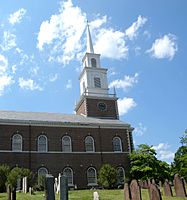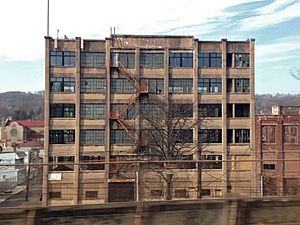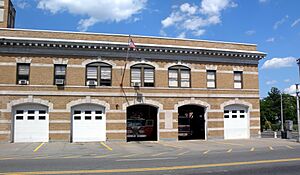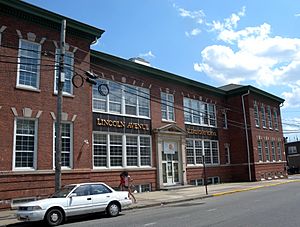Orange, New Jersey facts for kids
Quick facts for kids
Orange, New Jersey
|
||
|---|---|---|
|
Township
|
||
| City of Orange Township | ||

The former First Presbyterian Church
|
||
|
||
| Country | ||
| State | ||
| County | Essex | |
| Incorporated | November 27, 1806 (as township) | |
| Reincorporated | April 3, 1872 (as city) | |
| Government | ||
| • Type | Faulkner Act Mayor-Council | |
| • Body | City Council | |
| Area | ||
| • Total | 2.22 sq mi (5.74 km2) | |
| • Land | 2.21 sq mi (5.73 km2) | |
| • Water | <0.01 sq mi (0.01 km2) 0.09% | |
| Area rank | 392nd of 565 in state 19th of 22 in county |
|
| Elevation | 197 ft (60 m) | |
| Population
(2020)
|
||
| • Total | 34,447 | |
| • Estimate
(2023)
|
33,787 | |
| • Rank | 69th of 565 in state 8th of 22 in county |
|
| • Density | 15,565.7/sq mi (6,010.0/km2) | |
| • Density rank | 17th of 565 in state 3rd of 22 in county |
|
| Time zone | UTC−05:00 (Eastern (EST)) | |
| • Summer (DST) | UTC−04:00 (Eastern (EDT)) | |
| ZIP Codes |
07050–07051
|
|
| Area code(s) | 973 | |
| FIPS code | {{{1}}}-{{{2}}} | |
| GNIS feature ID | 1729742 | |
The City of Orange (also called Orange) is a township in Essex County, New Jersey. In 2020, about 34,447 people lived there. This was an increase of over 4,300 people since 2010.
Orange was first set up as a township on November 27, 1806. It was formed from parts of Newark Township. Later, on April 3, 1872, Orange became a city. In 1982, it changed back to a township. This was done to get more government help for the city. The name Orange comes from William III of England or William IV, Prince of Orange.
Orange, East Orange, South Orange, and West Orange are often called "The Oranges" together.
Contents
Discovering Orange, New Jersey
A Look Back in Time
Orange started with families from Connecticut's New Haven Colony. In 1666, 30 families traveled to start a town near the Passayak River. This area included what is now Orange and other nearby towns. The land was given by King Charles II of England to his brother, James, Duke of York. James then gave the land to Lord John Berkeley and Sir George Carteret. Since Carteret was the governor of the Isle of Jersey, the land became known as "New Jersey."
Orange was first part of Newark and was called "Newark Mountains." On June 7, 1780, the people voted to call it Orange. They wanted to be separate from Newark. This finally happened on November 27, 1806.
On April 13, 1807, Orange elected its first government. It officially became a city on March 13, 1860. Soon after, the city started to split into smaller towns. This happened because of disagreements over how to pay for police, fire, and street services. South Orange formed in 1861, East Orange in 1863, and West Orange in 1863.
Early Transportation and Industry
Orange was an important stop for travelers. It was on the main road from Newark to Morristown. Many hotels were built there. At first, people traveled by stagecoach. Later, omnibuses (like early buses) also served Orange.
The Morris and Essex Railroad came to Orange in 1836. At first, horses pulled the train cars. But in 1837, the first steam locomotive arrived. This railroad is now part of NJ Transit's Morristown Line.
Trolley cars came later, in 1862. The first electric trolley in New Jersey ran on a line in Orange. Eventually, all trolleys and buses became part of a larger public transport system.
Orange became an industrial city early on. The tanning industry grew quickly because of many hemlock trees. These trees provided what was needed to make leather. This led to many factories making shoes and boots.
Orange was once known as the hat-making capital of the United States. This industry started there in 1792. By 1892, 21 companies made hats, employing over 3,700 people. They produced about 4.8 million hats each year! The famous "Stetson" hat company was started by brothers from Orange. By 1960, all hat factories had left the city.
Beer was also a big industry in Orange in the early 1900s. The first brewery was built in 1901. Beer production stopped during Prohibition (when alcohol was illegal). After Prohibition ended, the brewery was sold and made Rheingold Beer. It closed permanently in 1977.
Other important companies in Orange included the Monroe Calculating Company, which made adding machines. The Bates Manufacturing Company made office items like staplers. The United States Radium Corporation also had a factory here. They refined radium to make glowing paint for watch dials.
Famous People and Visitors
Orange has been home to many famous people. These include baseball player Monte Irvin and boxer Tony Galento. Actor William Bendix also lived and worked here. Presidents and governors have visited Orange. The city has held big celebrations for its 100th and 150th anniversaries.
Geography and Location
Orange covers about 2.22 square miles (5.74 square kilometers). Most of this is land, with a small amount of water.
The East Branch of the Rahway River flows through Orange.
Orange shares borders with several other towns in Essex County. These include East Orange, Glen Ridge, Montclair, South Orange, and West Orange.
Population and People
| Historical population | |||
|---|---|---|---|
| Census | Pop. | %± | |
| 1810 | 2,266 | — | |
| 1820 | 2,830 | 24.9% | |
| 1830 | 3,887 | 37.3% | |
| 1840 | 3,264 | * | −16.0% |
| 1850 | 4,385 | 34.3% | |
| 1860 | 8,877 | 102.4% | |
| 1870 | 9,348 | * | 5.3% |
| 1880 | 13,207 | 41.3% | |
| 1890 | 18,844 | 42.7% | |
| 1900 | 24,141 | 28.1% | |
| 1910 | 29,630 | 22.7% | |
| 1920 | 33,268 | 12.3% | |
| 1930 | 35,399 | 6.4% | |
| 1940 | 35,717 | 0.9% | |
| 1950 | 38,037 | 6.5% | |
| 1960 | 35,789 | −5.9% | |
| 1970 | 32,566 | −9.0% | |
| 1980 | 31,136 | −4.4% | |
| 1990 | 29,925 | −3.9% | |
| 2000 | 32,868 | 9.8% | |
| 2010 | 30,134 | −8.3% | |
| 2020 | 34,447 | 14.3% | |
| 2023 (est.) | 33,787 | 12.1% | |
| Population sources: 1810–1920 1840–1900 1840 1850–1870 1850 1870 1880–1890 1890–1910 1860–1930 1940–2000 2000 2010 2020 * = Lost territory in previous decade. |
|||
In 2020, Orange had 34,447 people. The population was made up of different groups. About 62.78% were Black or African American. About 28.98% were Hispanic or Latino (who can be of any race). White people made up about 3.11% of the population.
In 2010, there were 30,134 people living in Orange. About 25% of the people were under 18 years old. The average age was 34.4 years.
Emergency Services
Fire Department
The City of Orange has its own professional fire department. It was started in 1872. The department has two fire stations. They use fire engines, quints, and a ladder truck to fight fires and help people.
Education in Orange
The Orange Board of Education runs the public schools. Students from pre-kindergarten through 12th grade attend these schools. The district has 12 schools. The state helps pay for school building projects in these districts.
In the 2020–21 school year, about 5,629 students were enrolled. There were 507.5 teachers. This means there were about 11 students for every teacher. Some of the schools include:
- Orange Early Childhood Center (Pre-K)
- Central Elementary School (K–2)
- Lincoln Avenue School (K–7)
- Rosa Parks Central Community School (Grades 3–7)
- Orange Preparatory Academy (Grades 8–9)
- Orange High School (Grades 10–12)
- STEM Innovation Academy of the Oranges (Grades 9–12)
The Orange Public Library has 200,000 books and other items. It lends out about 43,000 items each year. The library building opened in 1901.
Economy and Business
Parts of Orange are in an Urban Enterprise Zone (UEZ). This is a special area that helps businesses grow. Orange was one of the first cities chosen for this program in 1983. Businesses in this zone can offer a lower sales tax rate. This helps encourage people to shop and businesses to invest in the area. Orange's special zone status is set to end in November 2023.
Getting Around Orange
Orange has about 44.64 miles of roads. Most of these roads are managed by the city.
Interstate 280 is the main highway in Orange. It runs east to west through the city. Another important road is County Route 508, which follows Central Avenue.
Public Transportation
Orange has two train stations: Orange and Highland Avenue. These stations offer NJ Transit train service. You can travel to Secaucus Junction and Penn Station in Midtown Manhattan. You can also go to Hoboken Terminal.
NJ Transit also has several bus routes in Orange. These buses connect to Newark and other local areas.
Notable People from Orange
Many interesting people have lived in or are connected to Orange:
- Robert Adams (born 1937), a photographer known for pictures of the American West.
- Jay Alford (born 1983), a football player for the Oakland Raiders.
- Bobby Bandiera (born 1953), a rock guitarist and songwriter.
- Stephen J. Benkovic (born 1938), a chemist.
- Ken Blanchard (born 1939), an author who wrote The One Minute Manager.
- Sandra Boynton (born 1953), a humorist, songwriter, and children's author.
- Lesley Bush (born 1947), an Olympic diver who won a gold medal in 1964.
- Samuel P. Bush (1863–1948), an industrialist and ancestor of the Bush political family.
- Bisa Butler (born 1973), a fiber artist known for her quilted portraits.
- Richard Codey (born 1946), a politician who was the 53rd Governor of New Jersey.
- Samuel Colgate (1822–1897), a manufacturer and philanthropist who led the Colgate soap company.
- John Condit (1755–1834), a United States Representative and Senator from New Jersey.
- Bobby Czyz (born 1962), a champion boxer.
- David Ferry (1924–2023), a poet and translator.
- Gail Fisher (1935–2000), an actress known for her role on Mannix.
- Tony Galento (1910–1979), a heavyweight boxer.
- Al Harrington (born 1980), a professional basketball player in the NBA.
- Edward V. Hartford (1870–1922), who perfected the automobile shock absorber.
- George Huntington Hartford (1833–1917), a mayor of Orange and owner of the Great Atlantic and Pacific Tea Company.
- Beatrice Hicks (1919–1979), founder of the Society of Women Engineers.
- Cleo Hill (1938–2015), a professional basketball player.
- Dulé Hill (born 1975), an actor known for Psych and The West Wing.
- Monte Irvin (1919–2016), a famous baseball player and Hall of Famer.
- Mark Kelly (born 1964), an astronaut. His twin brother, Scott Kelly, is also an astronaut.
- Lowell Mason (1792–1872), a composer of over 1600 hymn tunes, including "Joy to the World".
- George McClellan (1826–1885), an American Civil War general and later Governor of New Jersey, died here.
- John Milnor (born 1931), a mathematician who won the Fields Medal.
- Henry Steel Olcott (1832–1907), a founder of the Theosophical Society and helped create the Buddhist flag.
- Daniel Quillen (1940–2011), a mathematician who won the Fields Medal.
- Bill Raftery (born 1943), a basketball analyst and former coach.
- Jim Ringo (1931–2007), an NFL player and member of the Pro Football Hall of Fame.
- Roy Scheider (1932–2008), an actor known for films like Jaws.
- Morton Schindel (1918–2016), an educator and producer of animated children's films.
- John B. Stetson (1830-1906), a hat manufacturer who invented the cowboy hat.
- Leigh Howard Stevens (born 1953), a marimba artist.
- Lucy Stone (1818–1893), an abolitionist and suffragist.
- Dionne Warwick (born 1940), a famous singer and actress.
Places to Visit in Orange
- Orange Reservoir
- Rosedale Cemetery
- St. Johns Catholic Cemetery
- St. Johns Church
- Columbus Hall
See also
 In Spanish: Orange (Nueva Jersey) para niños
In Spanish: Orange (Nueva Jersey) para niños










